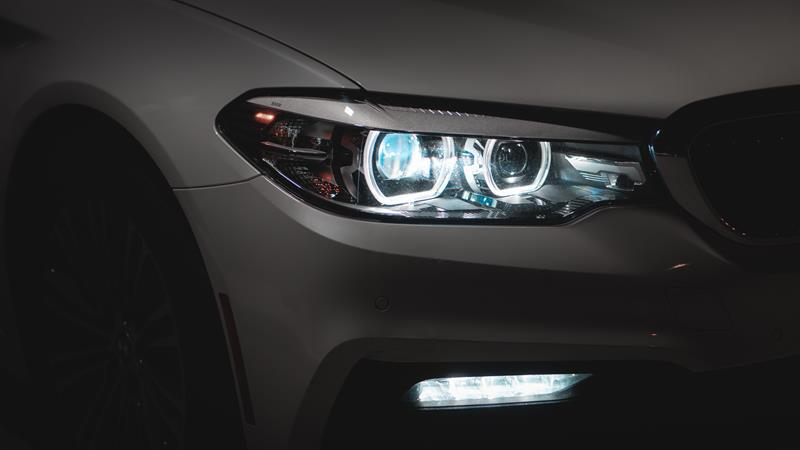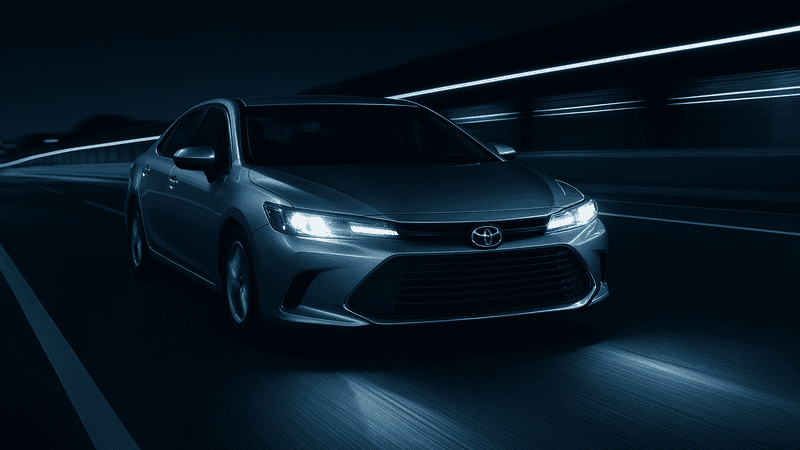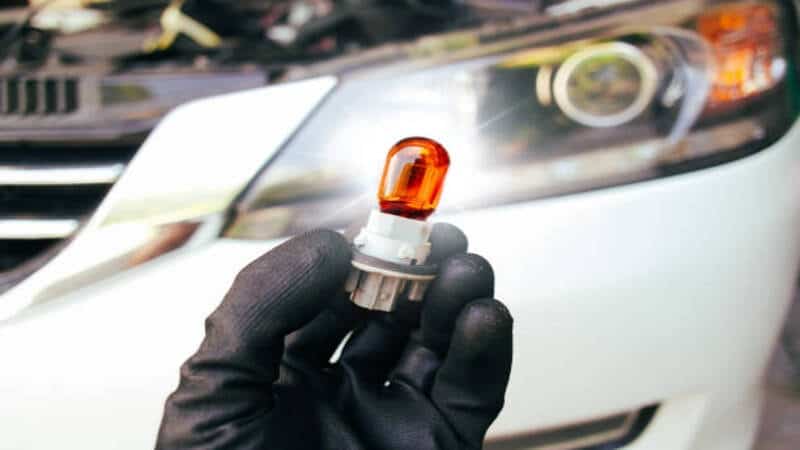There are multiple qualities to consider when upgrading headlights including compatibility with existing systems, cost, efficiency, and lifespan.
In this article, we put these two headlight options side by side, examining how they work and how their qualities compare to help you decide whether LED or HID is the technology to bet on today.
Understanding HID Headlights
The principles behind HID headlights are more than 100 years old, but HID lights were first used in cars in the 1990s. Back then, they were considered a vastly superior upgrade to traditional halogen headlights.
What are HID Headlights?
These are headlights that use high-intensity discharge (HID) technology to produce powerful beams of light. The light is emitted by passing a powerful electric arc through a gas inside a sealed glass tube. The electric arc is created between two tungsten electrodes inside the tube.
HID headlights are sometimes referred to as Xenon headlights because this is the signature gas inside the glass tube. However, Xenon gas is only used when the HID bulbs are initially switched on. Once optimal illumination is achieved, other gases in the tube are ionized in its place.

How do HID Headlights Work?
HID headlights have a ballast and a bulb (sealed glass tube). The ballast helps to provide the voltage required to start illumination and regulates the current after optimal illumination levels have been achieved.
When the headlights are turned on, a high-voltage pulse from the ballast is sent to the HID bulbs. This causes the ionization of xenon gas and halide salts in the bulbs, producing light. After this initial ignition, the HID bulbs require a few moments to warm up and achieve optimal illumination.
As the bulbs warms up, more of the halide salts are vaporized by the rising temperatures and the resistance between the electrodes falls. When this happens, the ballast switches to a continuous operation mode, only supplying enough current to maintain the light output from the bulbs without flickering.
Understanding LED Headlights
The technology used in LED headlamps is much younger than HID technology. LED bulbs were first installed in cars in the 2000s, but adoption has ramped up significantly in recent years as the technology continues to improve.

What are LED Headlights?
The light from an LED headlight comes from light-emitting diodes or LEDs. These are semiconductors that produce light when an electric current is passed through them. The electric current causes the movement of electrons which causes them to release energy in the form of light.
How do LED Headlights Work?
Like all diodes, light-emitting diodes contain two separate regions. When the headlights are switched on, a current is applied, and the free electrons in one region of the diode cross into the other region. To do this, the electrons have to release some energy.
In other semiconductor materials, this energy is released as heat. However, in LEDs, this energy is released in the form of light.
Comparison Between HID and LED Headlights
| Feature | HID Headlight | LED Headlight |
|---|---|---|
| Technology | Uses high-intensity discharge technology. | Uses light emitting diodes |
| Cost | Were considered cheaper in the past but some LED headlights are now comparably priced. | Were more expensive than HIDs but LEDs are progressively getting cheaper with greater adoption. |
| Lifespan | 2000 – 8000 hours | 25,000 – 50000 hours |
| Brightness | Upto 8000 Lumens (Bright) | Upto 10000 Lumens (Brighter) |
| Compatibility | Conversion kit required | Conversion kit required for many but not all LED lights |
| Light Distance | 300 meters | 300 meters |
| Colors | Yellow, White, Blue, Purple | Yellow, White, Blue, Purple |
| Glare | Intense | Less intense compared to HID |
| Energy Efficiency | Good energy efficiency | Excellent energy efficiency. Better than HID |
| Ease of Replacement | Easy | Easier |
| Brightness over time | Fades with time | No change with time |
This table compares the performance of HID and LED headlights based on several parameters, including brightness, cost, and lifespan.
Are LEDs Better than HIDs
Less than a decade ago, it was easy to think of LED bulbs as an expensive alternative to HID headlights that lasted longer but weren’t as good. However, in the past decade, LED headlight technology has continued to improve while HID technology has remained more or less the same.
What Does the Data Say?
LED headlights are now at par or superior to HID headlights in key areas, including:
- Lifespan: This has always been the main selling point of LEDs and some LED headlight bulbs are said to last as much as 50,000 hours.
- Brightness: An LED bulb can produce as much as 10000 lumens, while a HID bulb is unlikely to exceed 8000 lumens. When high-quality LED bulbs are professionally installed, they’ll be the brightest things on the road.
- Cost: An LED headlight would cost significantly more than an HID headlight in the past. However, increased adoption and improvements in the technology have made it possible to get LED headlights that are comparably priced to some HID lights.
- Lifetime Performance: HID lights are less energy efficient than LEDs, and this gets worse with age. The HID colors may shift, and more voltage will be needed to produce the same amount of light. LED headlights may dim as the light-emitting diode degrades, but this is a much slower process.
The Fine Print
Looking at the data, it is easy to conclude that LEDs are the better option. However, not all LED headlights are equal,l regardless of the specifications. Additionally, the quality of installation will determine the quality of illumination and glare from your headlights.

Factors to Consider When Choosing Between HID and LED Headlights
When you’re choosing between LED and HID lights, certain factors can guide you to the most appropriate solution for you. These are explained below.
1. Budget
Many buyers will find themselves restricted by how much they can pay for new headlights. At some price points, the quality of LED headlights will be poorer than similarly priced HID headlights. However, the cost of good quality LED headlights has been getting lower, and many buyers consider the long-term savings to be worth the extra cost.
2. Usage
For some car owners, driving at night or in other conditions that require headlights is a regular thing, e.g., truck drivers. Drivers who use their headlights more frequently will find the lifespan and brightness of their headlights to be more important than initial costs.

3. Regulations
Many jurisdictions have regulations that determine how bright drivers’ headlights can be. This is an issue for both HID and LED headlights, but LED bulbs have become a greater concern since they are brighter and adoption rates have been high recently.
Check your local regulations to see whether the installation of HID or LED headlights is legal.
4. Age of Vehicle
When HID or LED headlights are installed as an aftermarket solution, the car’s electrical system may not be able to handle the retrofit. If a vehicle cannot handle the retrofit, it may be necessary to consider a different solution or perform a more extensive retrofit and change additional components.
5. Aesthetics
The aesthetics of HID and LED headlights are noticeably different and some consumers will prefer one over the other. LED headlights have been popular recently partly because they are perceived to have a sleeker, more modern look.
6. Extent of Retrofitting Needed

There are LED headlights today that can replace traditional halogen bulbs without requiring a conversion kit, i.e., plug-and-play. This option makes installation simpler but it is not available for HID systems which always require a conversion kit when upgrading from traditional halogen bulbs.
Additionally, car headlights can either use reflectors or projectors and both systems have their pros and cons. Some LED lights don’t produce the best results with reflector housings and switching from reflectors to projectors requires retrofitting.
When switching to a new HID or LED system requires a lot of retrofitting, this will make the upgrade more expensive. Additionally, retrofitting is best done by a licensed expert. Poorly installed headlights can perform poorly and pose a risk to other motorists.
In Conclusion
High-intensity discharge headlights were once the ideal option when upgrading traditional halogen headlights. However, LED technology has improved substantially in recent years. Adoption of the technology is increasing as the quality improves and costs decline.
HID headlights are still a great option and they offer great illumination for the price. However, the longer service life of LEDs, their aesthetics, and simpler installation means LED headlights will be the smart choice for many consumers going forward.
Why is Carlightvision the Place to Get LED Headlights?
Carlightvision has been trusted by more than 100 brands to manufacture high-quality LED lighting solutions. We are both manufacturers and innovators with an R&D team of more than 70 people. Our clients enjoy a wide range of customizations on their orders including eye-catching designs and labeling. Talk to our experts and see how we can light up your business today.




